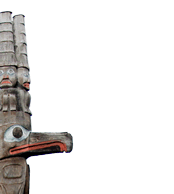 |
|||||||||||
 |
|||||||||||
 |
|||||||||||
 |
 |
||||||||||
 |
|||||||||||
 |
|||||||||||
 |
|||||||||||

A l'intérieur Wawadiťła |
||
| Cliquer et traîner dans l'image pour regarder l'intérieur de Wawadiťła | ||
Cloison de danse kwakwaka’wakw, 1977Sculpteur : Richard Hunt À l’arrière, directement en face de l’entrée, se trouve une cloison de danse qui sépare le coin où les danseurs se changent du reste de la maison. Ceci est une reproduction d’une autre cloison plus ancienne réalisée pour Mungo Martin par Willie Seaweed (env. 1873-1967) un autre artiste kwakwaka’wakw bien connu. La cloison fut peinte par Richard Hunt alors qu’il se trouvait employé par le programme de sculpture du Musée royal de la C.-B.
Tronc de percussion, 2003Sculpteurs : David Knox et Mervyn Child Un tronc de percussion façonné en forme de baleine se tient devant la cloison. Pendant les cérémonies, des groupes de chanteurs sont assis de chaque côté du tronc et le frappent à l’aide de bâtons pour marquer le rythme des chansons. Auparavant, un autre tronc avait été sculpté pour Wawadiťła par Richard Hunt. Cette reproduction fut réalisée par David Knox, l’arrière-petit-fils de Mungo Martin, et Mervyn Child, un descendant de la famille Hunt. Leur travail à Wawadiťła témoigne de l’importance que continue d’avoir le legs artistique de Mungo Martin. RBCM 17740 a-c.
|
||
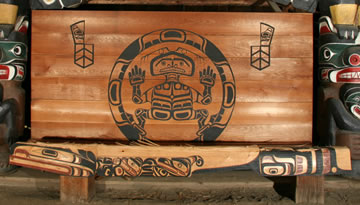 Mike Scott Photograph, RBCM Img0186a Mike Scott Photograph, RBCM Img0186a |
Une figure ressemblant à un être humain se trouve flanquée de deux boucliers de cuivre, une forme de richesse de la Côte Nord-Ouest. |
|
Houseposts, Rear of House |
||
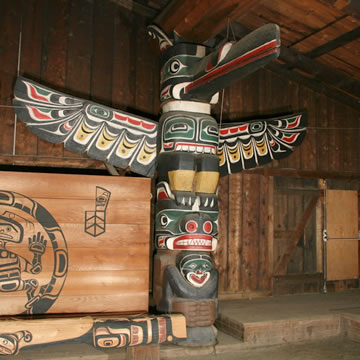 Mike Scott Photograph, RBCM Img0191 Mike Scott Photograph, RBCM Img0191 |
Huxwhukw, a companion of the cannibal Baxwbakwalanuxwsiwe', the supernatural spirit associated with the prestigious Hamatsa winter dance ceremony. It is the main crest of the Gixsam lineage of the Kwagu’ł. The birds’ beaks are hinged and can be made to open and shut. Grizzly Bear, a crest of the Wa'walibui lineage. |
|
Houseposts, Front of House |
||
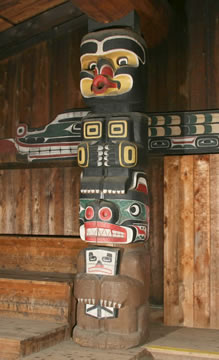 Mike Scott Photograph, Mike Scott Photograph, RBCM Img0194 |
Dzunukwa, a mythical wild woman who lives in the forest and is feared because she steals children. She is a sleepy, slow-moving giantess whose round mouth and protruding lips indicate her characteristic cry: ‘Hu, Hu, Hu’. This is a crest of the Kwikwasutinuxw people of Gilford Island. Grizzly Bear, a crest of the Wa'walibui lineage. |
|
Walls |
||
 Mike Scott Photograph, RBCM Img0192 Mike Scott Photograph, RBCM Img0192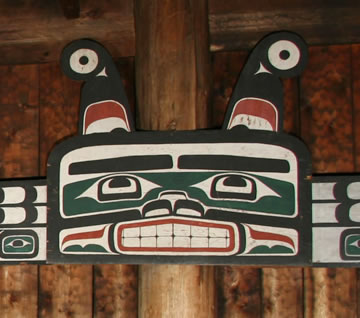 Mike Scott Photograph, RBCM Img0192a Mike Scott Photograph, RBCM Img0192a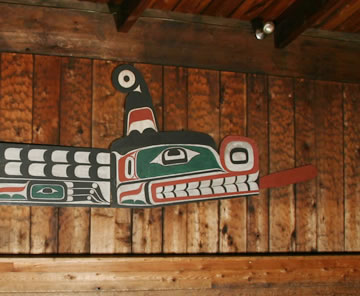 Mike Scott Photograph, RBCM Img0193 Mike Scott Photograph, RBCM Img0193 |
Sisiyutł, a supernatural
double-headed serpent. This powerful being, the blood of which can
turn people to stone, is a ‘Namgis crest. The Sisiyutł image on the entrance wall was acquired in 1913 by Charles F. Newcombe either at the ławiťsis village of Kalugwis on Tournour Island or at the ‘Namgis community of ‘Yalis (Alert Bay). In 1941, it was attached to the façade of a building in Thunderbird Park where canoes were displayed. The Sisiyutł carvings on the side walls were painted for the house in 1960 by Mungo Martin and Henry Hunt. |
|
| Retour |
